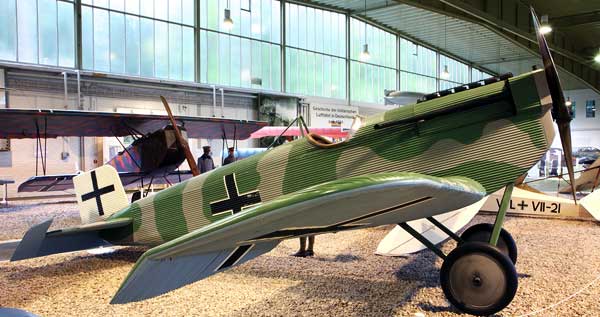
Paper Model Airplanes
JUNKERS D-1
The world's first all-metal aeroplane, the Junkers J. was completed in 1915 under the direction of Professor Hugo Junkers. Its structure consisted of ribbed metal I sheeting with internal tubular bracing.
Installed in the pointed nose was a 120 h.p. Mercedes engine, fitted with a 'chimney'-type exhaust pipe, and an interesting innovation-an under slung radiator. The wings were thick in section, with sharply cut tips and aileron' which extended behind the line of the trailing-edge. The fuselage was square in section. The tail and balanced rudder had square edges, and the whole appearance of the aircraft was strong but crude. Nicknamed the 'Blechesel' (Tin Donkey), the D-1 was, quite naturally, regarded with suspicion by the authorities.
In 1916 a development of the J-1, the J.2. was constructed; a single-seater fighter monoplane with remarkably modern lines. A deep under slung radiator was provided for its 160 h.p. Mercedes engine and a crash pylon was fixed behind the cockpit to protect the pilot in the event of the plane turning over. A single Spandau gun was synchronized to fire through the revolving airscrew. The J.2 was given the military designation of E-II, but only six examples. E250-255. were built.
Although Professor Junkers had achieved only partial success with his designs, officialdom was impressed with their strength, and persuaded him to work with Anthony Fokker on the design of a new armored two-seater biplane intended for army co-operation duty. The new model, the J.4 (military designation J-I), proved to be most useful, but relations between the partners were never happy.
The next Junkers fighter design was the J.7, another all-metal monoplane, which made its appearance in October 1917. In its early form, the nose installation of its 160 h.p. Mercedes engine was fairly well streamlined and the airscrew had a small spinner. A clumsy exhaust pipe stretched down the starboard side of the fuselage. Almost as an afterthought, a radiator was fixed inconveniently above the cylinders. Wing construction consisted of ribbed aluminum, braced internally by seven parallel tubular metal spars interconnected to form Warren girders.
Oddly shaped unequal-chord ailerons replaced the original rotating wingtips. The fuselage was covered with horizontally corrugated metal strips. Both elevators and rudder were balanced. A high head-rest behind the cockpit acted as a crash pylon. A second 17 had a neat under slung radiator, modified undercarriage and a blunt nose without a spinner; the headrest was reduced to skeleton form. A third version, equipped with a car-type radiator, was an excellent aeroplane and would have performed with success at the Adlershof fighter competition in January 1918. Unfortunately, only four weeks before the contest it sustained damage, when flown by Fokker himself.